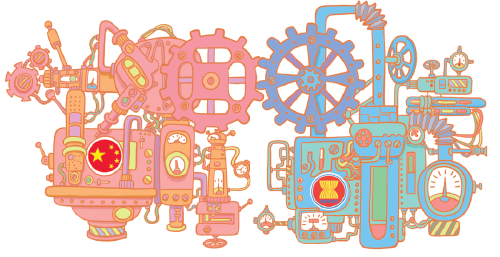
JIN DING/CHINA DAILY
Enhancing China-ASEAN production capacity cooperation would give a big boost to the post-pandemic recovery of the regional economy
Recently, the 24th ASEAN Plus China, Japan, ROK Leaders' Meeting was successfully held. Premier Li Keqiang attended the meeting online and said in his speech that ASEAN and the three countries have helped and supported each other, waged a joint fight against the pandemic and kept the regional industrial and supply chains stable. He also emphasized the need to enhance industrial cooperation in East Asia. As part of this, the strengthening of cooperation between China and ASEAN has become more prominent.
China and ASEAN have advanced cooperation on production capacity rapidly in recent years. And these efforts have made significant progress. China-ASEAN cooperation has become the most successful and dynamic model of regional cooperation in the Asia-Pacific. Since the outbreak of the novel coronavirus, China-ASEAN production capacity cooperation, despite severe challenges, has maintained strong momentum and resilience. China supports better harnessing the existing "fast tracks" and "green lanes", to facilitate regional economic circulations.
The continuous promotion of the Belt and Road Initiative and the signing of the Regional Comprehensive Economic Partnership have also injected new energy into the production capacity cooperation between the two sides. For example, the BRI is synergized with the ASEAN Economic Community Blueprint 2025, the bloc's development plan, with a large number of key projects being steadily advanced.
Since the outbreak of the pandemic, the two sides have been carrying out close anti-pandemic cooperation, which has effectively maintained the stability of the regional industrial and supply chains. The two sides have not only overcome the difficulties together, with China having already provided 190 million doses of COVID-19 vaccines to the ASEAN countries, but also realized continued growth of bilateral trade and in-depth development of production capacity cooperation, a bright spot in the world economy which is still struggling amid the pandemic.
In 2020, ASEAN became China's largest trading partner, with the bilateral trade volume reaching $684.60 billion, a year-on-year increase of 6.7 percent. In the first eight months of this year, ASEAN has maintained that status. According to statistics from China's General Administration of Customs, China' imports and exports to the ASEAN countries reached a total value of $553.92 billion, an increase of 33.3 percent, accounting for 14.5 percent of China's total foreign trade value during that period. Meanwhile, China has continued to be ASEAN's largest trading partner for the 12th consecutive year.
Although the pandemic has brought about severe economic challenges and disrupted industrial chains, it has also provided China and ASEAN with an opportunity to reinforce and reshape the regional industrial chains. In the future, China and the ASEAN countries, in the broader context of the unstable global industrial chains and the continuing pandemic, need to make more efforts to strengthen their economic and trade investment and cooperation as well as production capacity cooperation.
First, intergovernmental communication and coordination in production capacity cooperation need to be enhanced. The two sides should conduct in-depth research into the areas for production capacity cooperation and the methods, and formulate concrete development goals that serve the interests of both sides. For example, as many ASEAN countries have demands to improve their infrastructure and thus have actual needs for such traditional industries as steel and cement, the two sides can cooperate on production capacity in these fields, although they must pay close attention to environmental pollution and respond to the concerns of relevant parties.
Moreover, they must pay attention to the different stages of economic development and the different infrastructure demands of countries in the region. The two sides should actively explore and establish a new model of China-ASEAN production capacity cooperation with the focus on high-quality cooperation for sustainable development and the improvement of people's livelihoods and well-being.
The cooperation mechanism for production capacity cooperation needs to be improved so that it solves the problems facing the investment enterprises, including corporate financing, cost reductions, efficiency improvement and risk sharing. These efforts will provide a strong guarantee for China-ASEAN production capacity cooperation.
Second, the areas of cooperation need to be expanded. In the past, the areas of China-ASEAN production capacity cooperation were mostly concentrated in traditional industries such as railway construction, mining production, electric power and equipment manufacturing. The level and quality of cooperation need to be raised. Therefore, the two sides should highlight areas such as energy conservation, environmental protection and information technology. It is also necessary to actively explore production capacity cooperation in the digital economy, including the application of big data, cloud computing and artificial intelligence.,
Third, cooperation in the fight against the novel coronavirus needs to be improved by setting up a permanent joint anti-pandemic prevention and control mechanism. Although China-ASEAN bilateral trade and investment has grown this year, the long-tail effects of the COVID-19 pandemic should not be underestimated. In this context, it is particularly important to jointly ensure supplies of vaccines and the stability of the industrial and supply chains. Parts of the industrial chains need reshaping, so as to further promote the in-depth integration of China-ASEAN economies, and accelerate the building of a China-ASEAN community with a shared future. Deepening China-ASEAN production capacity cooperation would not only improve their position in the international industrial chains, but also provide a powerful boost to the post-pandemic recovery of the regional economy.
(Jia DuQiang, a research associate of the National Institute of International Strategy at the Chinese Academy of Social Sciences. The author contributed this article to China Watch, a think tank powered by China Daily. The views do not necessarily reflect those of this platform.)






